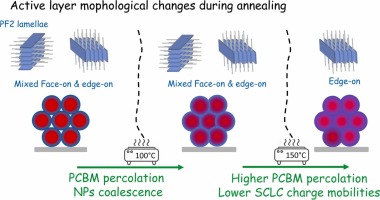Maxime M. Rammal , Paul Nizet, Géraldine Layrac, Sufal Swaraj, Benoît Heinrich, Jiang Jing, Emilie Steveler, Thomas Heiser, Nicolas Leclerc, Patrick Lévêque, Anne Hébrauda,
Aqueous dispersions of organic semiconducting nanoparticles (NPs) are particularly attractive as inks for the environmentally friendly preparation of organic solar cells. The internal morphology of the NPs, which depends on their elaboration process, is a key parameter, which has a significant influence on the final morphology of the active layer and therefore its effectiveness. In the present study, core-shell (PF2:PC71BM) NPs were prepared by miniemulsion. Their internal morphology including the composition of the two phases was characterized by scanning transmission X-ray microscopy (STXM) showing a core composed of 77% PC71BM and a shell composed of 75% PF2. It was found that thermal annealing promotes PC71BM diffusion from the core to the shell, increasing its proportion in the shell from 25% to 42%. This annealing, when applied after NPs deposition by spincoating, allows partial coalescence of the NPs, reducing the roughness of the active layer, and increases electron mobility, thus demonstrating the formation of PC71BM percolation paths for electron transport. A PCE of 1.6% could thus be obtained after 10 min of thermal annealing at 100◦C. At higher temperature, Grazing- Incidence Wide-Angle X-Ray Scattering (GIWAXS) analyses demonstrate the modification of the PF2 structura- tion from randomly oriented lamella after deposition to edge-on orientation after annealing, leading to an un- favorable decrease of the hole mobility in the direction perpendicular to the substrate, while increasing the hole mobility in the substrate plane. This study demonstrates the need to systematically characterize the internal morphology of NPs in order to rationalize the morphology of the active layer and optimize its properties.
